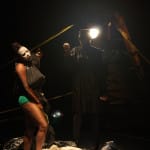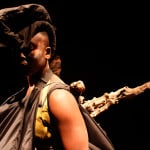- Okwui Okpokwasili and Nora Chipaumire perform Miriam
- Okwui Okpokwasili and Nora Chipaumire perform Miriam
- Nora Chipaumire in Miriam
With Miriam, the renowned choregrapher and dancer Nora Chipaumire creates her first character-driven work — a deeply personal dance-theater performance that reverberates with tensions: between public expectations and private desires, between objectification and power, and between darkness and light. Miriam invites the audience into an immersive experience of being an outsider, requiring the engagement of all five senses.
The inspiration for Miriam springs from the cultural and political milieu of Chipaumire’s southern African girlhood, her self-exile to the United States, and her self-discovery as an artist. Additional literary and legendary influences — the writings of Joseph Conrad and novelist Chenjerai Hove; the life of South African singer and activist Miriam Makeba; and the Christian iconography of Mary — come into the work as layers of text, sound, and image that enrich the mysterious and haunting world of Chipaumire’s creation.
In the performance, the persona embodied by Chipaumire emerges from a pile of rocks onstage to convey a woman’s struggles with the burden of objectification and the weight of resistance in a world defined largely by others. Her efforts are abetted by an otherworldly character, both angel and devil, performed by Okwui Okpokwasili. In their interplay, Miriam renders in vivid images the intensity of women who fight to create themselves despite the dual legacies of strict cultural traditions and imperialist racial views that define female beauty and power.
Nora Chipaumire In Her Own Words
For the past ten years, I have been investigating Africa and discovering my private iconography – stones, tennis shoes, ululations, whistles, bare light bulbs – all objects and sounds that define place. Physical movement is my first language, but words can and often do work as a barrier to — or boundary of — interpretation, understanding, or meaning. In constructing my theatrical world, a world in which I have full agency and power, I have been creating self-portraits that I hope convey political, aesthetic, and historical purpose whilst complicating, implicating, and destroying the concept of the African female body as subjugated, colonial, tribal, un-knowable. My intention is to engage “art canons” — Western as well as African — without selling my native culture on a global market, or losing my connection and responsibility to my native culture.
With Miriam, I am implicating my own physical being in a vast geographic and historic landscape. My Miriam is disobedient, obstinate, rebellious, and beloved, in keeping with the meaning of her name in both its Levite and Hebrew origins — a name carried by the mother of Jesus, the sister of Aaron and Moses, as well as the iconic singer and political activist Miriam Makeba.
About Nora Chipaumire
Born in Mutare, Zimbabwe and based in New York City, Chipaumire has been challenging stereotypes of Africa and the black performing body, art, and aesthetic for the past decade. She has studied dance in many parts of the world including Africa (Senegal, Burkina Faso, Kenya, and South Africa), Cuba, Jamaica, and the United States. A graduate of the University of Zimbabwe’s School of Law, Chipaumire holds a M.A. in Dance and M.F.A. in Choreography and Performance from Mills College, Oakland, CA.
Chipaumire is a 2012 Alpert Award in the Arts recipient and 2011 United States Artist Ford Fellow. She is also a two-time New York Dance and Performance (aka “Bessie”) Awardee: in 2008 for her dance-theater work, Chimurenga, and in 2007 for her body of work with Urban Bush Women, where she was a featured performer for six years (2003-2008) and Associate Artistic Director (2007-2008). She is the recipient of the 2009 AFROPOP Real Life Award for her choreography in the film Nora. She has also been awarded the 2007 Mariam McGlone Emerging Choreographer Award from Wesleyan University Center for the Arts, and a MANCC Choreographic Fellowship in 2007-2008.
Recent works include The Last Heifer (2012), commissioned by Danspace Project for Platform 2012, Parellels; Visible (2011), commissioned by Harlem Stage and created in collaboration with Jawole Willa Jo Zollar; Kimya (2011), a work for Jokajok!, a female ensemble based in Kenya; I Ka Nye (You Look Good) (2010), created and performed with Fred Bendongue; and lions will roar, swans will fly, angels will wrestle heaven, rains will break: gukurahundi (2009), created and performed with Thomas Mapfumo. She is featured in several films, including Dark Swan (dir. Laurie Coyle, 2011); the award-winning Nora (dir. Alla Kovgan & David Hinton, 2008); and the documentary Movement (R)evolution Africa (a story of an art form in four acts) (dir. Joan Frosch & Alla Kovgan, 2006).
Chipaumire has been an adjunct faculty member at Arizona State University-Tempe, Bennington College, University of Minnesota-Minneapolis, and Barnard College.
Support
This presentation of Miriam was made possible by the New England Foundation for the Arts’ National Dance Project, with lead funding from the Doris Duke Charitable Foundation and additional funding from The Andrew W. Mellon Foundation.
Miriam has received generous support form: The MAP Fund, a program of Creative Capital supported by the Doris Duke Charitable Foundation and The Andrew W. Mellon Foundation; The New England Foundation for the Arts’ National Dance Project, with lead funding from the Doris Duke Charitable Foundation and additional funding from The Andrew W. Mellon Foundation; The New England Foundation for the Arts’ Production Residency for Dance Program, with funding from The Andrew W. Mellon Foundation; The National Endowment for the Arts; The NPN Forth Fund; New Music USA’s Live Music for Dance Program.
Miriam is a National Performance Network (NPN) Creation Fund Project co-commissioned by the Flynn Center for the Performing Arts in partnership with the Experimental Media and Performing Arts Center (EMPAC) and NPN. The Creation Fund is supported by the Doris Duke Charitable Foundation, Ford Foundation, and the National Endowment for the Arts (a federal agency). Miriam is also co-commissioned by Brooklyn Academy of Music, Brooklyn, NY; Les Subsistences, Lyon, France; and Clarice Smith Performing Arts Center, University of Maryland, College Park.
Miriam was created during a residency provided by The Joyce Theater Foundation, New York City, with major support from the Rockefeller Foundation’s NYC Cultural Innovation Fund and the Rockefeller Brothers Fund. Creative and production residencies were also provided by EMPAC (Troy, NY), Brooklyn Academy of Music (Brooklyn, NY), MASS MoCA (North Adams, MA), Centro per la Scena Contemporanea (Bassano del Grappa, Italy), and Les Subsistences (Lyon, France).



